Analysis of Mental Health Models, Skills, and Diverse Populations
VerifiedAdded on 2020/05/04
|10
|3502
|119
Report
AI Summary
This report examines various aspects of mental health, encompassing medical models, population approaches, and the characteristics of depression. It details the strengths and weaknesses of the medical model, outlines features of a population-based approach, and describes the symptoms and treatments for depression. The report also explores the importance of listening to lived experiences in mental health, highlighting how this approach enhances diagnosis, treatment, and the creation of supportive relationships. It further discusses essential practice skills in engagement, assessment, and case management, providing insights into organizational, interpersonal, and communication skills, as well as the skills needed for effective mental health assessments. Finally, the report addresses mental health challenges faced by young people, analyzing contributing factors and outlining a population approach to promote their well-being, considering factors such as procrastination, financial concerns, and work-life balance.

UNIT:
NAME:
DATE:
NAME:
DATE:
Secure Best Marks with AI Grader
Need help grading? Try our AI Grader for instant feedback on your assignments.
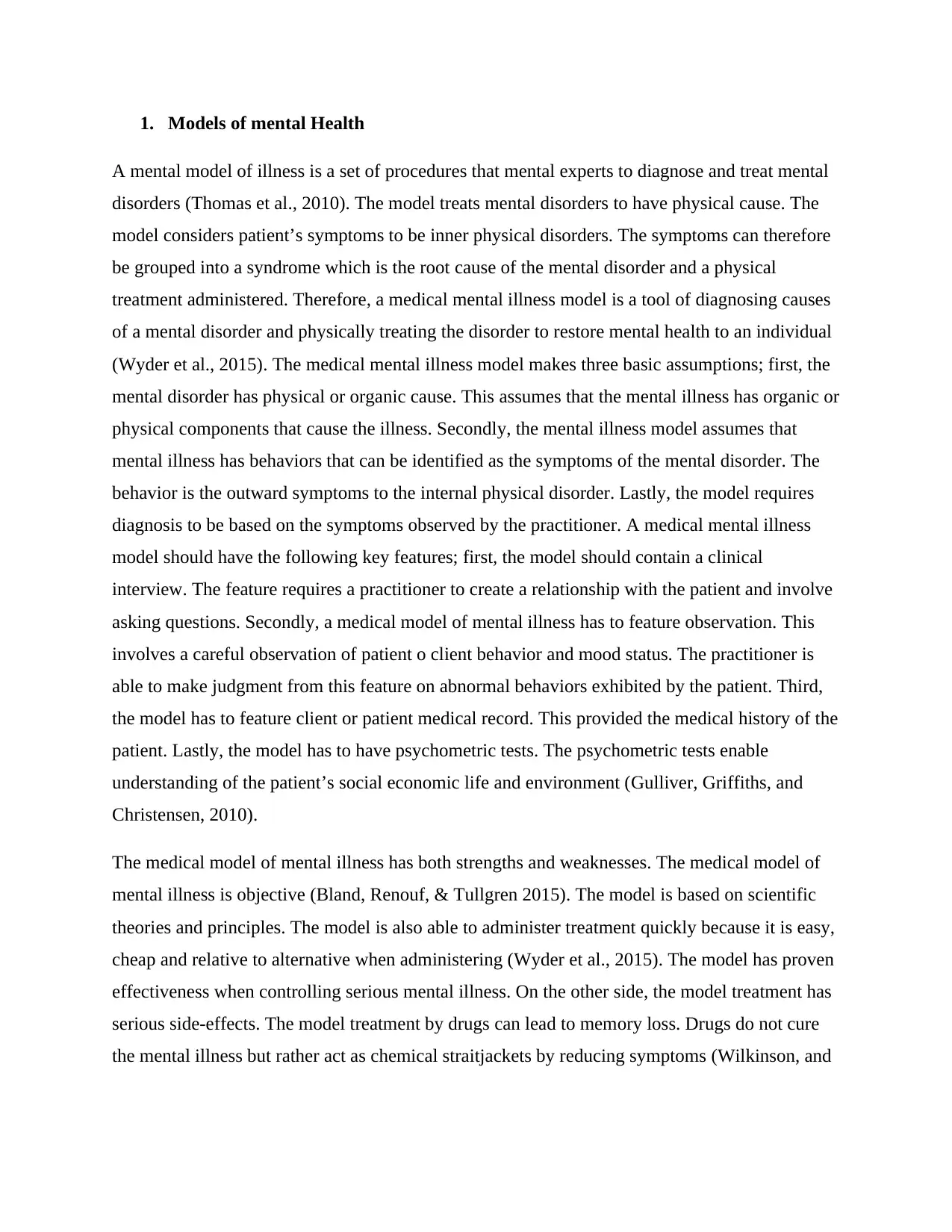
1. Models of mental Health
A mental model of illness is a set of procedures that mental experts to diagnose and treat mental
disorders (Thomas et al., 2010). The model treats mental disorders to have physical cause. The
model considers patient’s symptoms to be inner physical disorders. The symptoms can therefore
be grouped into a syndrome which is the root cause of the mental disorder and a physical
treatment administered. Therefore, a medical mental illness model is a tool of diagnosing causes
of a mental disorder and physically treating the disorder to restore mental health to an individual
(Wyder et al., 2015). The medical mental illness model makes three basic assumptions; first, the
mental disorder has physical or organic cause. This assumes that the mental illness has organic or
physical components that cause the illness. Secondly, the mental illness model assumes that
mental illness has behaviors that can be identified as the symptoms of the mental disorder. The
behavior is the outward symptoms to the internal physical disorder. Lastly, the model requires
diagnosis to be based on the symptoms observed by the practitioner. A medical mental illness
model should have the following key features; first, the model should contain a clinical
interview. The feature requires a practitioner to create a relationship with the patient and involve
asking questions. Secondly, a medical model of mental illness has to feature observation. This
involves a careful observation of patient o client behavior and mood status. The practitioner is
able to make judgment from this feature on abnormal behaviors exhibited by the patient. Third,
the model has to feature client or patient medical record. This provided the medical history of the
patient. Lastly, the model has to have psychometric tests. The psychometric tests enable
understanding of the patient’s social economic life and environment (Gulliver, Griffiths, and
Christensen, 2010).
The medical model of mental illness has both strengths and weaknesses. The medical model of
mental illness is objective (Bland, Renouf, & Tullgren 2015). The model is based on scientific
theories and principles. The model is also able to administer treatment quickly because it is easy,
cheap and relative to alternative when administering (Wyder et al., 2015). The model has proven
effectiveness when controlling serious mental illness. On the other side, the model treatment has
serious side-effects. The model treatment by drugs can lead to memory loss. Drugs do not cure
the mental illness but rather act as chemical straitjackets by reducing symptoms (Wilkinson, and
A mental model of illness is a set of procedures that mental experts to diagnose and treat mental
disorders (Thomas et al., 2010). The model treats mental disorders to have physical cause. The
model considers patient’s symptoms to be inner physical disorders. The symptoms can therefore
be grouped into a syndrome which is the root cause of the mental disorder and a physical
treatment administered. Therefore, a medical mental illness model is a tool of diagnosing causes
of a mental disorder and physically treating the disorder to restore mental health to an individual
(Wyder et al., 2015). The medical mental illness model makes three basic assumptions; first, the
mental disorder has physical or organic cause. This assumes that the mental illness has organic or
physical components that cause the illness. Secondly, the mental illness model assumes that
mental illness has behaviors that can be identified as the symptoms of the mental disorder. The
behavior is the outward symptoms to the internal physical disorder. Lastly, the model requires
diagnosis to be based on the symptoms observed by the practitioner. A medical mental illness
model should have the following key features; first, the model should contain a clinical
interview. The feature requires a practitioner to create a relationship with the patient and involve
asking questions. Secondly, a medical model of mental illness has to feature observation. This
involves a careful observation of patient o client behavior and mood status. The practitioner is
able to make judgment from this feature on abnormal behaviors exhibited by the patient. Third,
the model has to feature client or patient medical record. This provided the medical history of the
patient. Lastly, the model has to have psychometric tests. The psychometric tests enable
understanding of the patient’s social economic life and environment (Gulliver, Griffiths, and
Christensen, 2010).
The medical model of mental illness has both strengths and weaknesses. The medical model of
mental illness is objective (Bland, Renouf, & Tullgren 2015). The model is based on scientific
theories and principles. The model is also able to administer treatment quickly because it is easy,
cheap and relative to alternative when administering (Wyder et al., 2015). The model has proven
effectiveness when controlling serious mental illness. On the other side, the model treatment has
serious side-effects. The model treatment by drugs can lead to memory loss. Drugs do not cure
the mental illness but rather act as chemical straitjackets by reducing symptoms (Wilkinson, and
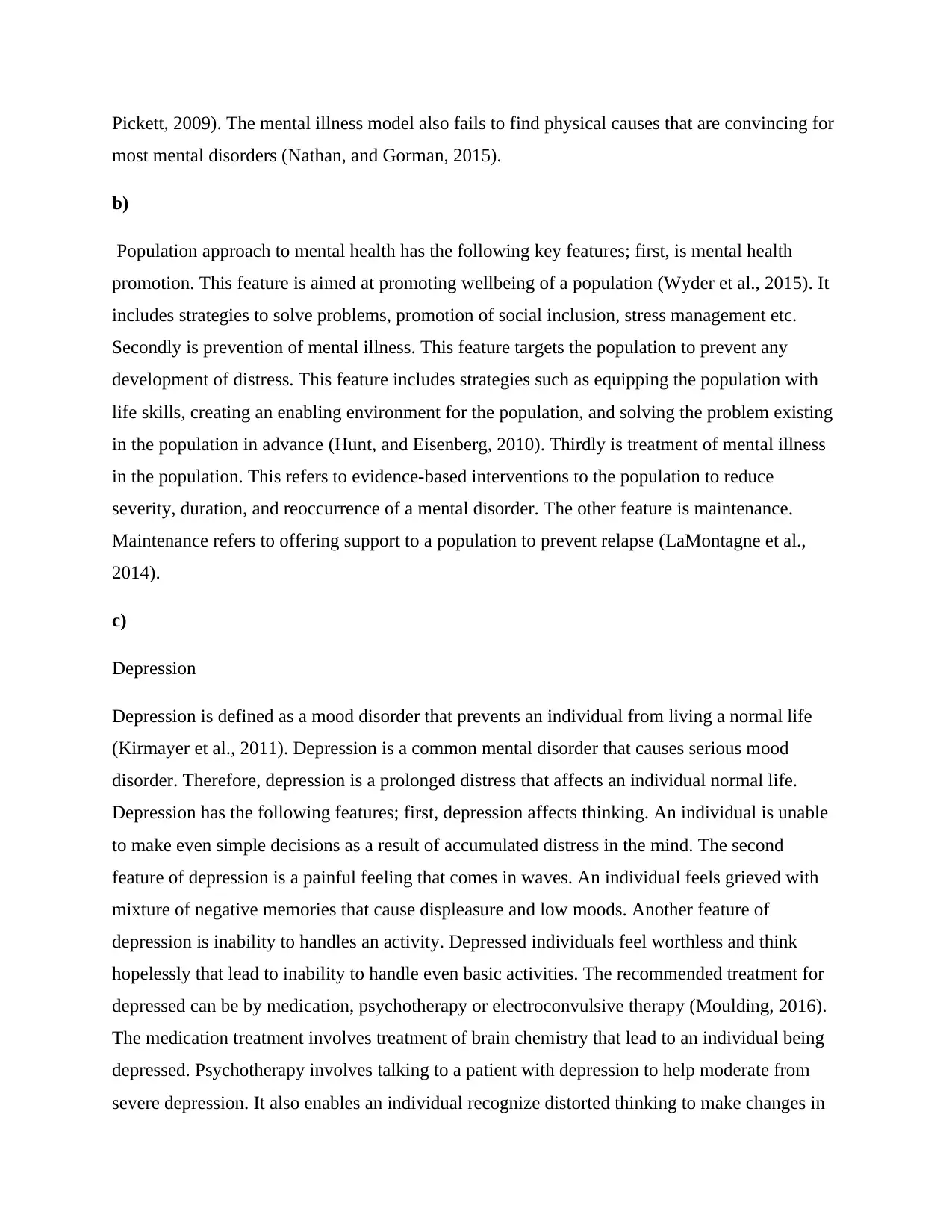
Pickett, 2009). The mental illness model also fails to find physical causes that are convincing for
most mental disorders (Nathan, and Gorman, 2015).
b)
Population approach to mental health has the following key features; first, is mental health
promotion. This feature is aimed at promoting wellbeing of a population (Wyder et al., 2015). It
includes strategies to solve problems, promotion of social inclusion, stress management etc.
Secondly is prevention of mental illness. This feature targets the population to prevent any
development of distress. This feature includes strategies such as equipping the population with
life skills, creating an enabling environment for the population, and solving the problem existing
in the population in advance (Hunt, and Eisenberg, 2010). Thirdly is treatment of mental illness
in the population. This refers to evidence-based interventions to the population to reduce
severity, duration, and reoccurrence of a mental disorder. The other feature is maintenance.
Maintenance refers to offering support to a population to prevent relapse (LaMontagne et al.,
2014).
c)
Depression
Depression is defined as a mood disorder that prevents an individual from living a normal life
(Kirmayer et al., 2011). Depression is a common mental disorder that causes serious mood
disorder. Therefore, depression is a prolonged distress that affects an individual normal life.
Depression has the following features; first, depression affects thinking. An individual is unable
to make even simple decisions as a result of accumulated distress in the mind. The second
feature of depression is a painful feeling that comes in waves. An individual feels grieved with
mixture of negative memories that cause displeasure and low moods. Another feature of
depression is inability to handles an activity. Depressed individuals feel worthless and think
hopelessly that lead to inability to handle even basic activities. The recommended treatment for
depressed can be by medication, psychotherapy or electroconvulsive therapy (Moulding, 2016).
The medication treatment involves treatment of brain chemistry that lead to an individual being
depressed. Psychotherapy involves talking to a patient with depression to help moderate from
severe depression. It also enables an individual recognize distorted thinking to make changes in
most mental disorders (Nathan, and Gorman, 2015).
b)
Population approach to mental health has the following key features; first, is mental health
promotion. This feature is aimed at promoting wellbeing of a population (Wyder et al., 2015). It
includes strategies to solve problems, promotion of social inclusion, stress management etc.
Secondly is prevention of mental illness. This feature targets the population to prevent any
development of distress. This feature includes strategies such as equipping the population with
life skills, creating an enabling environment for the population, and solving the problem existing
in the population in advance (Hunt, and Eisenberg, 2010). Thirdly is treatment of mental illness
in the population. This refers to evidence-based interventions to the population to reduce
severity, duration, and reoccurrence of a mental disorder. The other feature is maintenance.
Maintenance refers to offering support to a population to prevent relapse (LaMontagne et al.,
2014).
c)
Depression
Depression is defined as a mood disorder that prevents an individual from living a normal life
(Kirmayer et al., 2011). Depression is a common mental disorder that causes serious mood
disorder. Therefore, depression is a prolonged distress that affects an individual normal life.
Depression has the following features; first, depression affects thinking. An individual is unable
to make even simple decisions as a result of accumulated distress in the mind. The second
feature of depression is a painful feeling that comes in waves. An individual feels grieved with
mixture of negative memories that cause displeasure and low moods. Another feature of
depression is inability to handles an activity. Depressed individuals feel worthless and think
hopelessly that lead to inability to handle even basic activities. The recommended treatment for
depressed can be by medication, psychotherapy or electroconvulsive therapy (Moulding, 2016).
The medication treatment involves treatment of brain chemistry that lead to an individual being
depressed. Psychotherapy involves talking to a patient with depression to help moderate from
severe depression. It also enables an individual recognize distorted thinking to make changes in
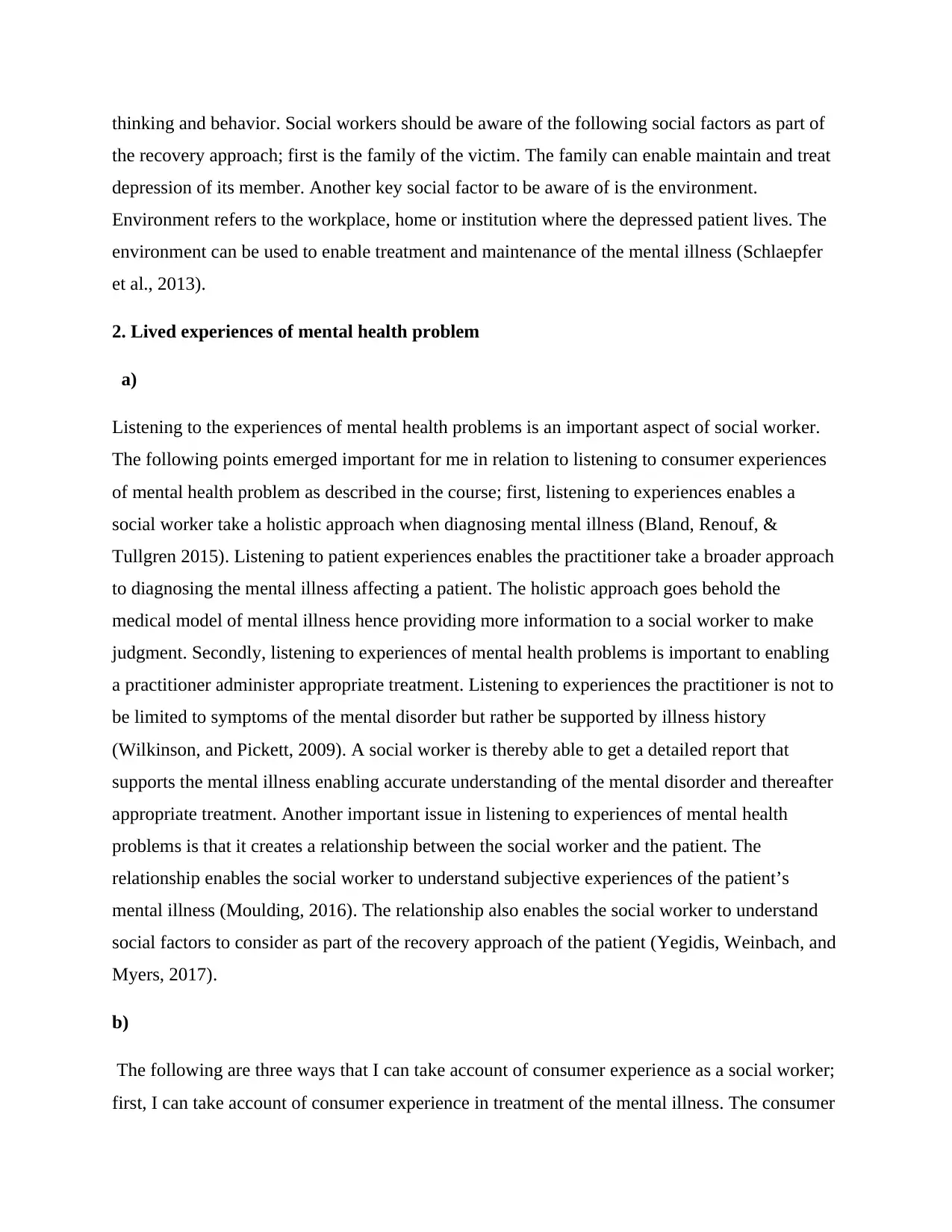
thinking and behavior. Social workers should be aware of the following social factors as part of
the recovery approach; first is the family of the victim. The family can enable maintain and treat
depression of its member. Another key social factor to be aware of is the environment.
Environment refers to the workplace, home or institution where the depressed patient lives. The
environment can be used to enable treatment and maintenance of the mental illness (Schlaepfer
et al., 2013).
2. Lived experiences of mental health problem
a)
Listening to the experiences of mental health problems is an important aspect of social worker.
The following points emerged important for me in relation to listening to consumer experiences
of mental health problem as described in the course; first, listening to experiences enables a
social worker take a holistic approach when diagnosing mental illness (Bland, Renouf, &
Tullgren 2015). Listening to patient experiences enables the practitioner take a broader approach
to diagnosing the mental illness affecting a patient. The holistic approach goes behold the
medical model of mental illness hence providing more information to a social worker to make
judgment. Secondly, listening to experiences of mental health problems is important to enabling
a practitioner administer appropriate treatment. Listening to experiences the practitioner is not to
be limited to symptoms of the mental disorder but rather be supported by illness history
(Wilkinson, and Pickett, 2009). A social worker is thereby able to get a detailed report that
supports the mental illness enabling accurate understanding of the mental disorder and thereafter
appropriate treatment. Another important issue in listening to experiences of mental health
problems is that it creates a relationship between the social worker and the patient. The
relationship enables the social worker to understand subjective experiences of the patient’s
mental illness (Moulding, 2016). The relationship also enables the social worker to understand
social factors to consider as part of the recovery approach of the patient (Yegidis, Weinbach, and
Myers, 2017).
b)
The following are three ways that I can take account of consumer experience as a social worker;
first, I can take account of consumer experience in treatment of the mental illness. The consumer
the recovery approach; first is the family of the victim. The family can enable maintain and treat
depression of its member. Another key social factor to be aware of is the environment.
Environment refers to the workplace, home or institution where the depressed patient lives. The
environment can be used to enable treatment and maintenance of the mental illness (Schlaepfer
et al., 2013).
2. Lived experiences of mental health problem
a)
Listening to the experiences of mental health problems is an important aspect of social worker.
The following points emerged important for me in relation to listening to consumer experiences
of mental health problem as described in the course; first, listening to experiences enables a
social worker take a holistic approach when diagnosing mental illness (Bland, Renouf, &
Tullgren 2015). Listening to patient experiences enables the practitioner take a broader approach
to diagnosing the mental illness affecting a patient. The holistic approach goes behold the
medical model of mental illness hence providing more information to a social worker to make
judgment. Secondly, listening to experiences of mental health problems is important to enabling
a practitioner administer appropriate treatment. Listening to experiences the practitioner is not to
be limited to symptoms of the mental disorder but rather be supported by illness history
(Wilkinson, and Pickett, 2009). A social worker is thereby able to get a detailed report that
supports the mental illness enabling accurate understanding of the mental disorder and thereafter
appropriate treatment. Another important issue in listening to experiences of mental health
problems is that it creates a relationship between the social worker and the patient. The
relationship enables the social worker to understand subjective experiences of the patient’s
mental illness (Moulding, 2016). The relationship also enables the social worker to understand
social factors to consider as part of the recovery approach of the patient (Yegidis, Weinbach, and
Myers, 2017).
b)
The following are three ways that I can take account of consumer experience as a social worker;
first, I can take account of consumer experience in treatment of the mental illness. The consumer
Secure Best Marks with AI Grader
Need help grading? Try our AI Grader for instant feedback on your assignments.
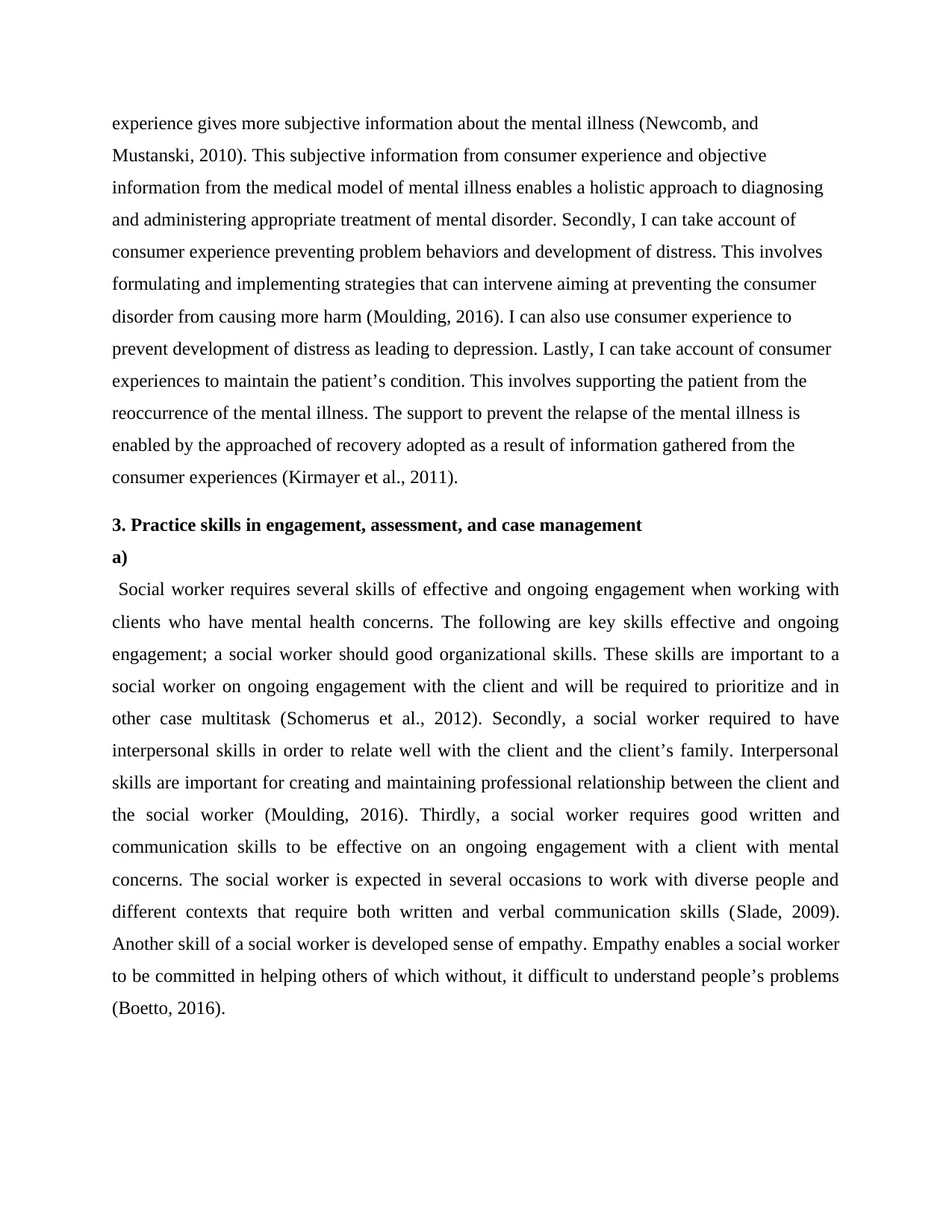
experience gives more subjective information about the mental illness (Newcomb, and
Mustanski, 2010). This subjective information from consumer experience and objective
information from the medical model of mental illness enables a holistic approach to diagnosing
and administering appropriate treatment of mental disorder. Secondly, I can take account of
consumer experience preventing problem behaviors and development of distress. This involves
formulating and implementing strategies that can intervene aiming at preventing the consumer
disorder from causing more harm (Moulding, 2016). I can also use consumer experience to
prevent development of distress as leading to depression. Lastly, I can take account of consumer
experiences to maintain the patient’s condition. This involves supporting the patient from the
reoccurrence of the mental illness. The support to prevent the relapse of the mental illness is
enabled by the approached of recovery adopted as a result of information gathered from the
consumer experiences (Kirmayer et al., 2011).
3. Practice skills in engagement, assessment, and case management
a)
Social worker requires several skills of effective and ongoing engagement when working with
clients who have mental health concerns. The following are key skills effective and ongoing
engagement; a social worker should good organizational skills. These skills are important to a
social worker on ongoing engagement with the client and will be required to prioritize and in
other case multitask (Schomerus et al., 2012). Secondly, a social worker required to have
interpersonal skills in order to relate well with the client and the client’s family. Interpersonal
skills are important for creating and maintaining professional relationship between the client and
the social worker (Moulding, 2016). Thirdly, a social worker requires good written and
communication skills to be effective on an ongoing engagement with a client with mental
concerns. The social worker is expected in several occasions to work with diverse people and
different contexts that require both written and verbal communication skills (Slade, 2009).
Another skill of a social worker is developed sense of empathy. Empathy enables a social worker
to be committed in helping others of which without, it difficult to understand people’s problems
(Boetto, 2016).
Mustanski, 2010). This subjective information from consumer experience and objective
information from the medical model of mental illness enables a holistic approach to diagnosing
and administering appropriate treatment of mental disorder. Secondly, I can take account of
consumer experience preventing problem behaviors and development of distress. This involves
formulating and implementing strategies that can intervene aiming at preventing the consumer
disorder from causing more harm (Moulding, 2016). I can also use consumer experience to
prevent development of distress as leading to depression. Lastly, I can take account of consumer
experiences to maintain the patient’s condition. This involves supporting the patient from the
reoccurrence of the mental illness. The support to prevent the relapse of the mental illness is
enabled by the approached of recovery adopted as a result of information gathered from the
consumer experiences (Kirmayer et al., 2011).
3. Practice skills in engagement, assessment, and case management
a)
Social worker requires several skills of effective and ongoing engagement when working with
clients who have mental health concerns. The following are key skills effective and ongoing
engagement; a social worker should good organizational skills. These skills are important to a
social worker on ongoing engagement with the client and will be required to prioritize and in
other case multitask (Schomerus et al., 2012). Secondly, a social worker required to have
interpersonal skills in order to relate well with the client and the client’s family. Interpersonal
skills are important for creating and maintaining professional relationship between the client and
the social worker (Moulding, 2016). Thirdly, a social worker requires good written and
communication skills to be effective on an ongoing engagement with a client with mental
concerns. The social worker is expected in several occasions to work with diverse people and
different contexts that require both written and verbal communication skills (Slade, 2009).
Another skill of a social worker is developed sense of empathy. Empathy enables a social worker
to be committed in helping others of which without, it difficult to understand people’s problems
(Boetto, 2016).
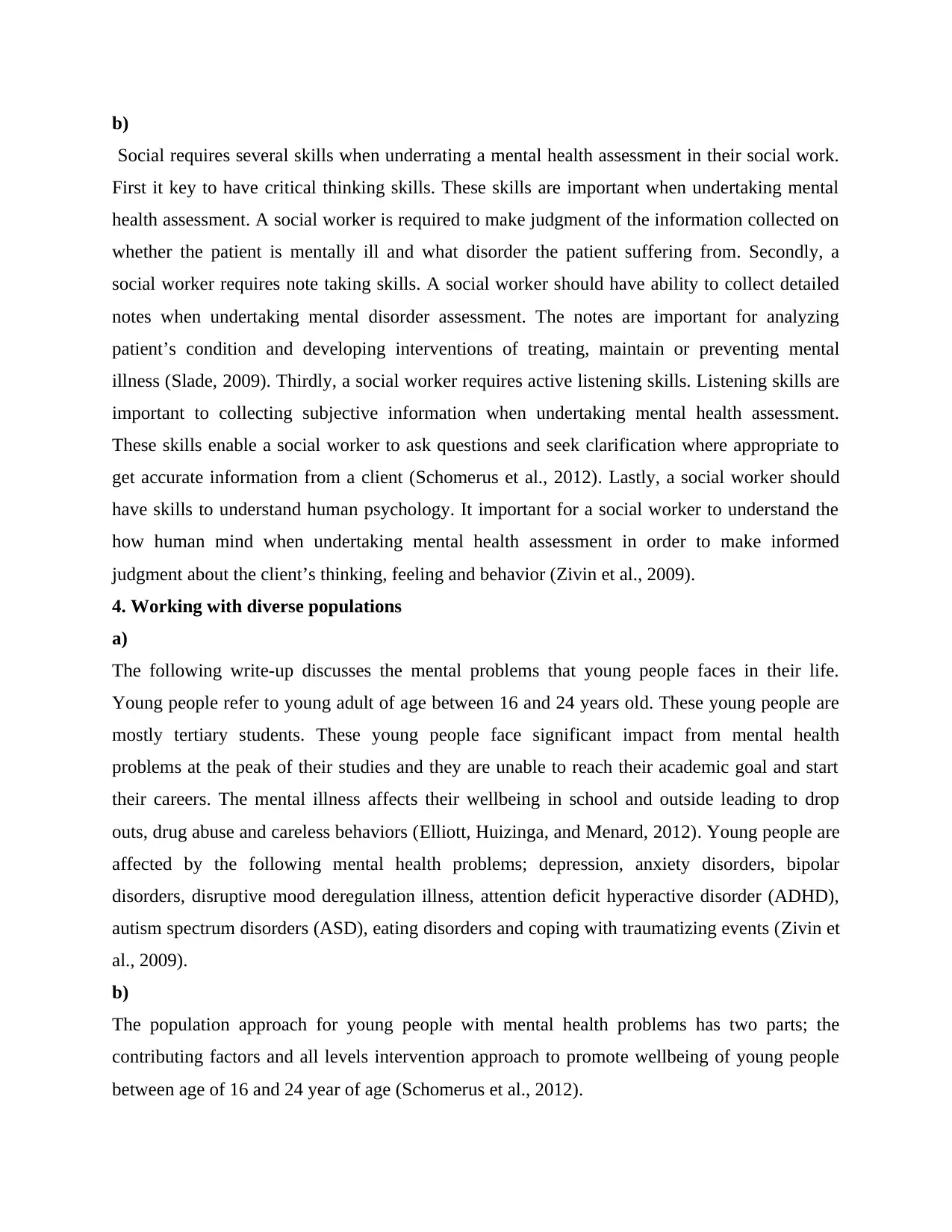
b)
Social requires several skills when underrating a mental health assessment in their social work.
First it key to have critical thinking skills. These skills are important when undertaking mental
health assessment. A social worker is required to make judgment of the information collected on
whether the patient is mentally ill and what disorder the patient suffering from. Secondly, a
social worker requires note taking skills. A social worker should have ability to collect detailed
notes when undertaking mental disorder assessment. The notes are important for analyzing
patient’s condition and developing interventions of treating, maintain or preventing mental
illness (Slade, 2009). Thirdly, a social worker requires active listening skills. Listening skills are
important to collecting subjective information when undertaking mental health assessment.
These skills enable a social worker to ask questions and seek clarification where appropriate to
get accurate information from a client (Schomerus et al., 2012). Lastly, a social worker should
have skills to understand human psychology. It important for a social worker to understand the
how human mind when undertaking mental health assessment in order to make informed
judgment about the client’s thinking, feeling and behavior (Zivin et al., 2009).
4. Working with diverse populations
a)
The following write-up discusses the mental problems that young people faces in their life.
Young people refer to young adult of age between 16 and 24 years old. These young people are
mostly tertiary students. These young people face significant impact from mental health
problems at the peak of their studies and they are unable to reach their academic goal and start
their careers. The mental illness affects their wellbeing in school and outside leading to drop
outs, drug abuse and careless behaviors (Elliott, Huizinga, and Menard, 2012). Young people are
affected by the following mental health problems; depression, anxiety disorders, bipolar
disorders, disruptive mood deregulation illness, attention deficit hyperactive disorder (ADHD),
autism spectrum disorders (ASD), eating disorders and coping with traumatizing events (Zivin et
al., 2009).
b)
The population approach for young people with mental health problems has two parts; the
contributing factors and all levels intervention approach to promote wellbeing of young people
between age of 16 and 24 year of age (Schomerus et al., 2012).
Social requires several skills when underrating a mental health assessment in their social work.
First it key to have critical thinking skills. These skills are important when undertaking mental
health assessment. A social worker is required to make judgment of the information collected on
whether the patient is mentally ill and what disorder the patient suffering from. Secondly, a
social worker requires note taking skills. A social worker should have ability to collect detailed
notes when undertaking mental disorder assessment. The notes are important for analyzing
patient’s condition and developing interventions of treating, maintain or preventing mental
illness (Slade, 2009). Thirdly, a social worker requires active listening skills. Listening skills are
important to collecting subjective information when undertaking mental health assessment.
These skills enable a social worker to ask questions and seek clarification where appropriate to
get accurate information from a client (Schomerus et al., 2012). Lastly, a social worker should
have skills to understand human psychology. It important for a social worker to understand the
how human mind when undertaking mental health assessment in order to make informed
judgment about the client’s thinking, feeling and behavior (Zivin et al., 2009).
4. Working with diverse populations
a)
The following write-up discusses the mental problems that young people faces in their life.
Young people refer to young adult of age between 16 and 24 years old. These young people are
mostly tertiary students. These young people face significant impact from mental health
problems at the peak of their studies and they are unable to reach their academic goal and start
their careers. The mental illness affects their wellbeing in school and outside leading to drop
outs, drug abuse and careless behaviors (Elliott, Huizinga, and Menard, 2012). Young people are
affected by the following mental health problems; depression, anxiety disorders, bipolar
disorders, disruptive mood deregulation illness, attention deficit hyperactive disorder (ADHD),
autism spectrum disorders (ASD), eating disorders and coping with traumatizing events (Zivin et
al., 2009).
b)
The population approach for young people with mental health problems has two parts; the
contributing factors and all levels intervention approach to promote wellbeing of young people
between age of 16 and 24 year of age (Schomerus et al., 2012).
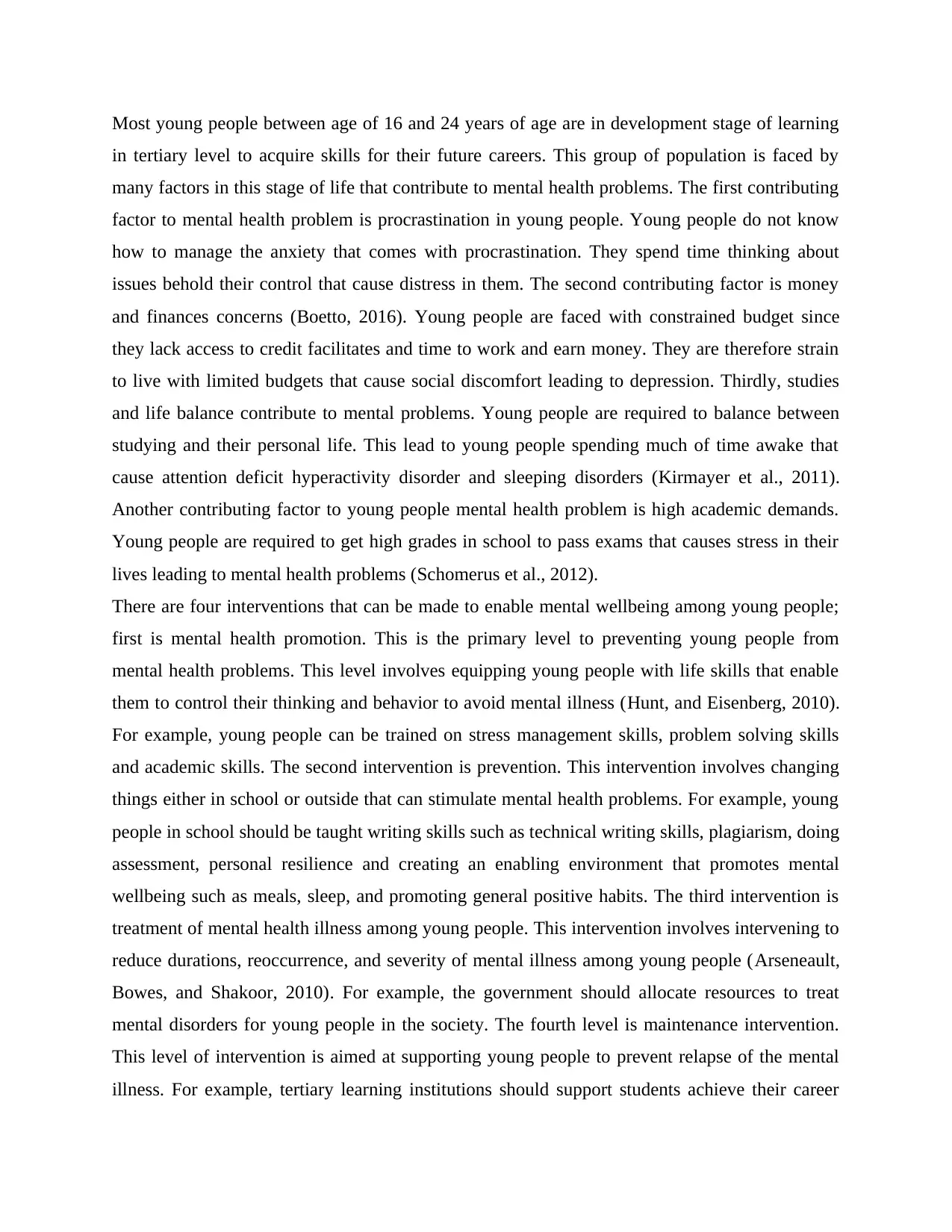
Most young people between age of 16 and 24 years of age are in development stage of learning
in tertiary level to acquire skills for their future careers. This group of population is faced by
many factors in this stage of life that contribute to mental health problems. The first contributing
factor to mental health problem is procrastination in young people. Young people do not know
how to manage the anxiety that comes with procrastination. They spend time thinking about
issues behold their control that cause distress in them. The second contributing factor is money
and finances concerns (Boetto, 2016). Young people are faced with constrained budget since
they lack access to credit facilitates and time to work and earn money. They are therefore strain
to live with limited budgets that cause social discomfort leading to depression. Thirdly, studies
and life balance contribute to mental problems. Young people are required to balance between
studying and their personal life. This lead to young people spending much of time awake that
cause attention deficit hyperactivity disorder and sleeping disorders (Kirmayer et al., 2011).
Another contributing factor to young people mental health problem is high academic demands.
Young people are required to get high grades in school to pass exams that causes stress in their
lives leading to mental health problems (Schomerus et al., 2012).
There are four interventions that can be made to enable mental wellbeing among young people;
first is mental health promotion. This is the primary level to preventing young people from
mental health problems. This level involves equipping young people with life skills that enable
them to control their thinking and behavior to avoid mental illness (Hunt, and Eisenberg, 2010).
For example, young people can be trained on stress management skills, problem solving skills
and academic skills. The second intervention is prevention. This intervention involves changing
things either in school or outside that can stimulate mental health problems. For example, young
people in school should be taught writing skills such as technical writing skills, plagiarism, doing
assessment, personal resilience and creating an enabling environment that promotes mental
wellbeing such as meals, sleep, and promoting general positive habits. The third intervention is
treatment of mental health illness among young people. This intervention involves intervening to
reduce durations, reoccurrence, and severity of mental illness among young people (Arseneault,
Bowes, and Shakoor, 2010). For example, the government should allocate resources to treat
mental disorders for young people in the society. The fourth level is maintenance intervention.
This level of intervention is aimed at supporting young people to prevent relapse of the mental
illness. For example, tertiary learning institutions should support students achieve their career
in tertiary level to acquire skills for their future careers. This group of population is faced by
many factors in this stage of life that contribute to mental health problems. The first contributing
factor to mental health problem is procrastination in young people. Young people do not know
how to manage the anxiety that comes with procrastination. They spend time thinking about
issues behold their control that cause distress in them. The second contributing factor is money
and finances concerns (Boetto, 2016). Young people are faced with constrained budget since
they lack access to credit facilitates and time to work and earn money. They are therefore strain
to live with limited budgets that cause social discomfort leading to depression. Thirdly, studies
and life balance contribute to mental problems. Young people are required to balance between
studying and their personal life. This lead to young people spending much of time awake that
cause attention deficit hyperactivity disorder and sleeping disorders (Kirmayer et al., 2011).
Another contributing factor to young people mental health problem is high academic demands.
Young people are required to get high grades in school to pass exams that causes stress in their
lives leading to mental health problems (Schomerus et al., 2012).
There are four interventions that can be made to enable mental wellbeing among young people;
first is mental health promotion. This is the primary level to preventing young people from
mental health problems. This level involves equipping young people with life skills that enable
them to control their thinking and behavior to avoid mental illness (Hunt, and Eisenberg, 2010).
For example, young people can be trained on stress management skills, problem solving skills
and academic skills. The second intervention is prevention. This intervention involves changing
things either in school or outside that can stimulate mental health problems. For example, young
people in school should be taught writing skills such as technical writing skills, plagiarism, doing
assessment, personal resilience and creating an enabling environment that promotes mental
wellbeing such as meals, sleep, and promoting general positive habits. The third intervention is
treatment of mental health illness among young people. This intervention involves intervening to
reduce durations, reoccurrence, and severity of mental illness among young people (Arseneault,
Bowes, and Shakoor, 2010). For example, the government should allocate resources to treat
mental disorders for young people in the society. The fourth level is maintenance intervention.
This level of intervention is aimed at supporting young people to prevent relapse of the mental
illness. For example, tertiary learning institutions should support students achieve their career
Paraphrase This Document
Need a fresh take? Get an instant paraphrase of this document with our AI Paraphraser

objectives by seeking internship programs for the students as they enter the labour market
(McGorry, Bates, and Birchwood, 2013).
(McGorry, Bates, and Birchwood, 2013).
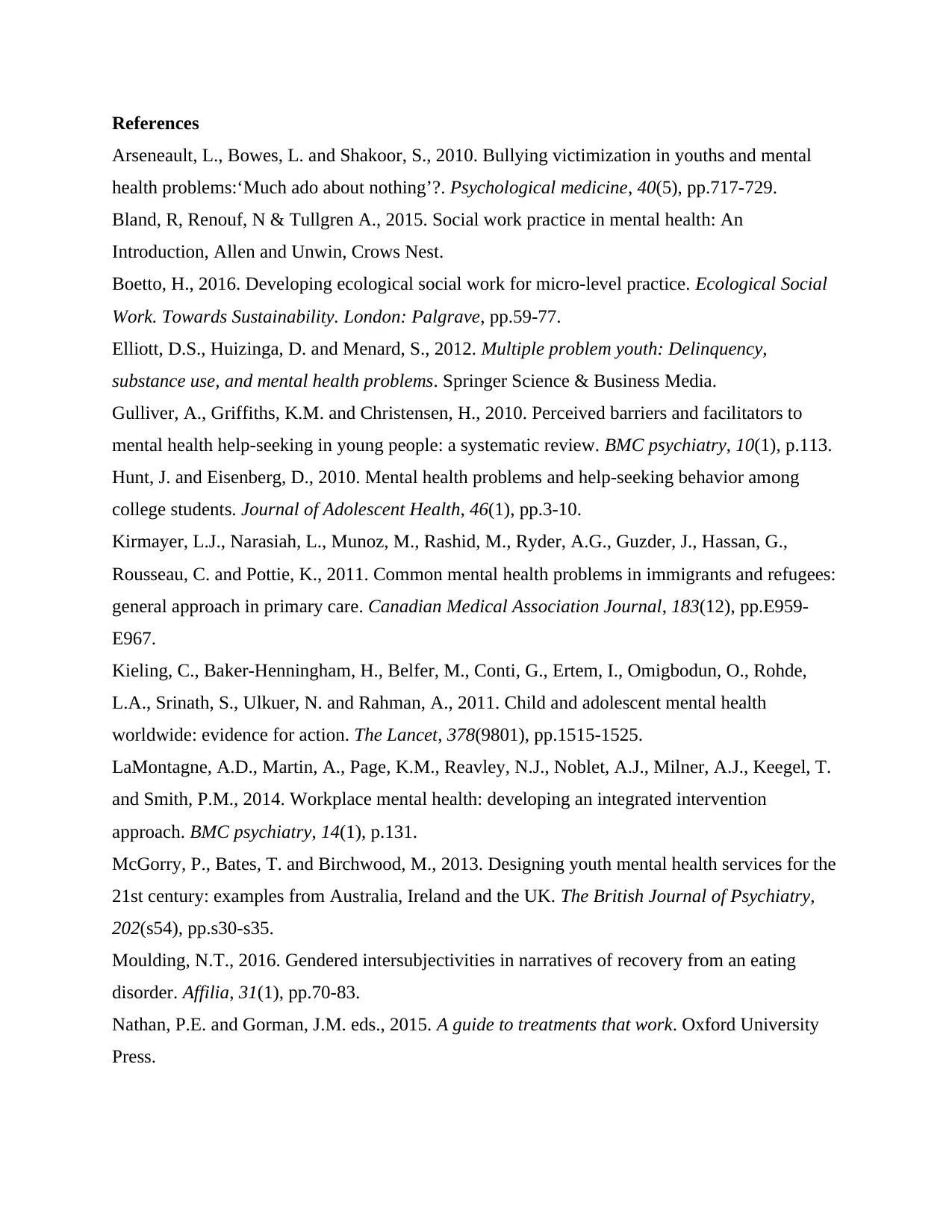
References
Arseneault, L., Bowes, L. and Shakoor, S., 2010. Bullying victimization in youths and mental
health problems:‘Much ado about nothing’?. Psychological medicine, 40(5), pp.717-729.
Bland, R, Renouf, N & Tullgren A., 2015. Social work practice in mental health: An
Introduction, Allen and Unwin, Crows Nest.
Boetto, H., 2016. Developing ecological social work for micro-level practice. Ecological Social
Work. Towards Sustainability. London: Palgrave, pp.59-77.
Elliott, D.S., Huizinga, D. and Menard, S., 2012. Multiple problem youth: Delinquency,
substance use, and mental health problems. Springer Science & Business Media.
Gulliver, A., Griffiths, K.M. and Christensen, H., 2010. Perceived barriers and facilitators to
mental health help-seeking in young people: a systematic review. BMC psychiatry, 10(1), p.113.
Hunt, J. and Eisenberg, D., 2010. Mental health problems and help-seeking behavior among
college students. Journal of Adolescent Health, 46(1), pp.3-10.
Kirmayer, L.J., Narasiah, L., Munoz, M., Rashid, M., Ryder, A.G., Guzder, J., Hassan, G.,
Rousseau, C. and Pottie, K., 2011. Common mental health problems in immigrants and refugees:
general approach in primary care. Canadian Medical Association Journal, 183(12), pp.E959-
E967.
Kieling, C., Baker-Henningham, H., Belfer, M., Conti, G., Ertem, I., Omigbodun, O., Rohde,
L.A., Srinath, S., Ulkuer, N. and Rahman, A., 2011. Child and adolescent mental health
worldwide: evidence for action. The Lancet, 378(9801), pp.1515-1525.
LaMontagne, A.D., Martin, A., Page, K.M., Reavley, N.J., Noblet, A.J., Milner, A.J., Keegel, T.
and Smith, P.M., 2014. Workplace mental health: developing an integrated intervention
approach. BMC psychiatry, 14(1), p.131.
McGorry, P., Bates, T. and Birchwood, M., 2013. Designing youth mental health services for the
21st century: examples from Australia, Ireland and the UK. The British Journal of Psychiatry,
202(s54), pp.s30-s35.
Moulding, N.T., 2016. Gendered intersubjectivities in narratives of recovery from an eating
disorder. Affilia, 31(1), pp.70-83.
Nathan, P.E. and Gorman, J.M. eds., 2015. A guide to treatments that work. Oxford University
Press.
Arseneault, L., Bowes, L. and Shakoor, S., 2010. Bullying victimization in youths and mental
health problems:‘Much ado about nothing’?. Psychological medicine, 40(5), pp.717-729.
Bland, R, Renouf, N & Tullgren A., 2015. Social work practice in mental health: An
Introduction, Allen and Unwin, Crows Nest.
Boetto, H., 2016. Developing ecological social work for micro-level practice. Ecological Social
Work. Towards Sustainability. London: Palgrave, pp.59-77.
Elliott, D.S., Huizinga, D. and Menard, S., 2012. Multiple problem youth: Delinquency,
substance use, and mental health problems. Springer Science & Business Media.
Gulliver, A., Griffiths, K.M. and Christensen, H., 2010. Perceived barriers and facilitators to
mental health help-seeking in young people: a systematic review. BMC psychiatry, 10(1), p.113.
Hunt, J. and Eisenberg, D., 2010. Mental health problems and help-seeking behavior among
college students. Journal of Adolescent Health, 46(1), pp.3-10.
Kirmayer, L.J., Narasiah, L., Munoz, M., Rashid, M., Ryder, A.G., Guzder, J., Hassan, G.,
Rousseau, C. and Pottie, K., 2011. Common mental health problems in immigrants and refugees:
general approach in primary care. Canadian Medical Association Journal, 183(12), pp.E959-
E967.
Kieling, C., Baker-Henningham, H., Belfer, M., Conti, G., Ertem, I., Omigbodun, O., Rohde,
L.A., Srinath, S., Ulkuer, N. and Rahman, A., 2011. Child and adolescent mental health
worldwide: evidence for action. The Lancet, 378(9801), pp.1515-1525.
LaMontagne, A.D., Martin, A., Page, K.M., Reavley, N.J., Noblet, A.J., Milner, A.J., Keegel, T.
and Smith, P.M., 2014. Workplace mental health: developing an integrated intervention
approach. BMC psychiatry, 14(1), p.131.
McGorry, P., Bates, T. and Birchwood, M., 2013. Designing youth mental health services for the
21st century: examples from Australia, Ireland and the UK. The British Journal of Psychiatry,
202(s54), pp.s30-s35.
Moulding, N.T., 2016. Gendered intersubjectivities in narratives of recovery from an eating
disorder. Affilia, 31(1), pp.70-83.
Nathan, P.E. and Gorman, J.M. eds., 2015. A guide to treatments that work. Oxford University
Press.
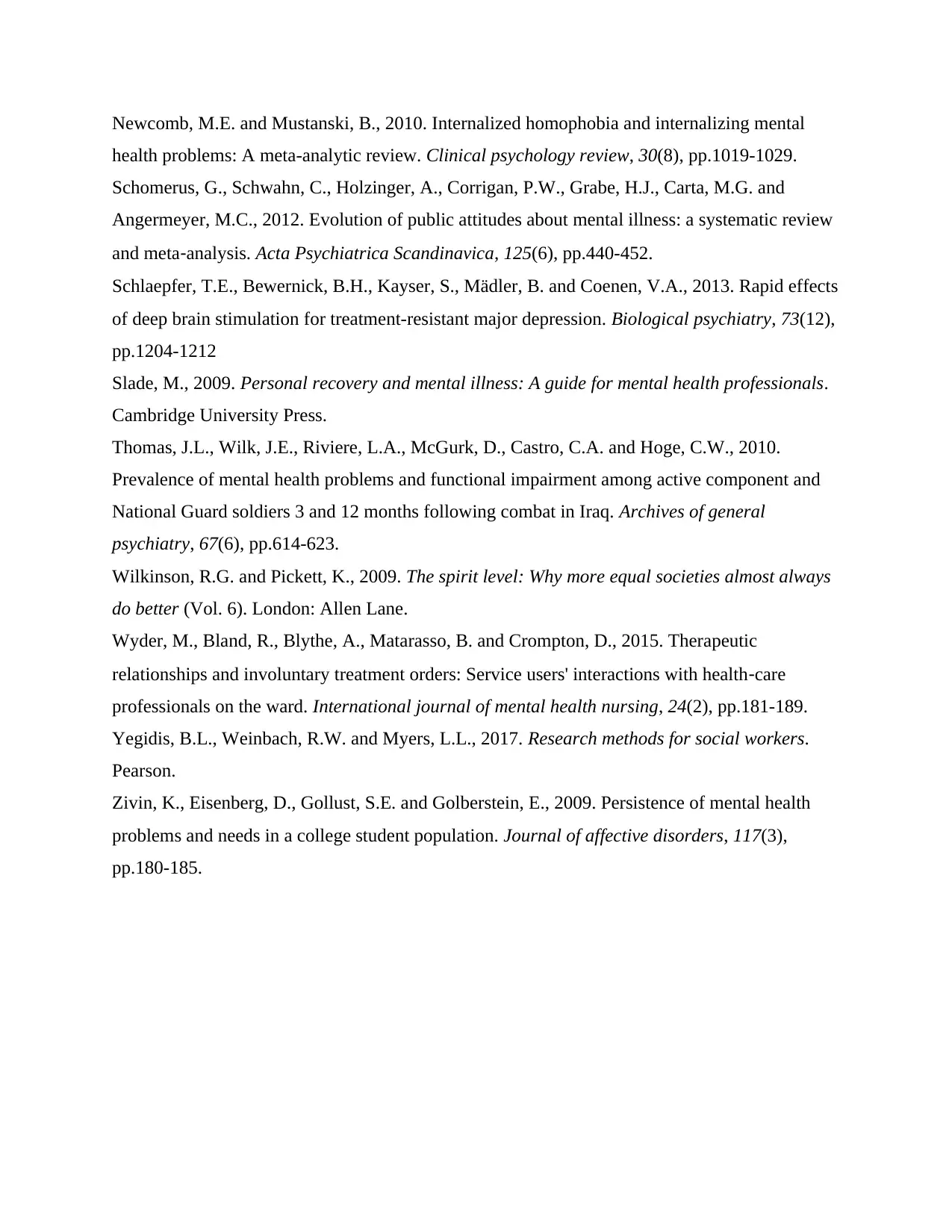
Newcomb, M.E. and Mustanski, B., 2010. Internalized homophobia and internalizing mental
health problems: A meta-analytic review. Clinical psychology review, 30(8), pp.1019-1029.
Schomerus, G., Schwahn, C., Holzinger, A., Corrigan, P.W., Grabe, H.J., Carta, M.G. and
Angermeyer, M.C., 2012. Evolution of public attitudes about mental illness: a systematic review
and meta‐analysis. Acta Psychiatrica Scandinavica, 125(6), pp.440-452.
Schlaepfer, T.E., Bewernick, B.H., Kayser, S., Mädler, B. and Coenen, V.A., 2013. Rapid effects
of deep brain stimulation for treatment-resistant major depression. Biological psychiatry, 73(12),
pp.1204-1212
Slade, M., 2009. Personal recovery and mental illness: A guide for mental health professionals.
Cambridge University Press.
Thomas, J.L., Wilk, J.E., Riviere, L.A., McGurk, D., Castro, C.A. and Hoge, C.W., 2010.
Prevalence of mental health problems and functional impairment among active component and
National Guard soldiers 3 and 12 months following combat in Iraq. Archives of general
psychiatry, 67(6), pp.614-623.
Wilkinson, R.G. and Pickett, K., 2009. The spirit level: Why more equal societies almost always
do better (Vol. 6). London: Allen Lane.
Wyder, M., Bland, R., Blythe, A., Matarasso, B. and Crompton, D., 2015. Therapeutic
relationships and involuntary treatment orders: Service users' interactions with health‐care
professionals on the ward. International journal of mental health nursing, 24(2), pp.181-189.
Yegidis, B.L., Weinbach, R.W. and Myers, L.L., 2017. Research methods for social workers.
Pearson.
Zivin, K., Eisenberg, D., Gollust, S.E. and Golberstein, E., 2009. Persistence of mental health
problems and needs in a college student population. Journal of affective disorders, 117(3),
pp.180-185.
health problems: A meta-analytic review. Clinical psychology review, 30(8), pp.1019-1029.
Schomerus, G., Schwahn, C., Holzinger, A., Corrigan, P.W., Grabe, H.J., Carta, M.G. and
Angermeyer, M.C., 2012. Evolution of public attitudes about mental illness: a systematic review
and meta‐analysis. Acta Psychiatrica Scandinavica, 125(6), pp.440-452.
Schlaepfer, T.E., Bewernick, B.H., Kayser, S., Mädler, B. and Coenen, V.A., 2013. Rapid effects
of deep brain stimulation for treatment-resistant major depression. Biological psychiatry, 73(12),
pp.1204-1212
Slade, M., 2009. Personal recovery and mental illness: A guide for mental health professionals.
Cambridge University Press.
Thomas, J.L., Wilk, J.E., Riviere, L.A., McGurk, D., Castro, C.A. and Hoge, C.W., 2010.
Prevalence of mental health problems and functional impairment among active component and
National Guard soldiers 3 and 12 months following combat in Iraq. Archives of general
psychiatry, 67(6), pp.614-623.
Wilkinson, R.G. and Pickett, K., 2009. The spirit level: Why more equal societies almost always
do better (Vol. 6). London: Allen Lane.
Wyder, M., Bland, R., Blythe, A., Matarasso, B. and Crompton, D., 2015. Therapeutic
relationships and involuntary treatment orders: Service users' interactions with health‐care
professionals on the ward. International journal of mental health nursing, 24(2), pp.181-189.
Yegidis, B.L., Weinbach, R.W. and Myers, L.L., 2017. Research methods for social workers.
Pearson.
Zivin, K., Eisenberg, D., Gollust, S.E. and Golberstein, E., 2009. Persistence of mental health
problems and needs in a college student population. Journal of affective disorders, 117(3),
pp.180-185.
1 out of 10
Related Documents
Your All-in-One AI-Powered Toolkit for Academic Success.
+13062052269
info@desklib.com
Available 24*7 on WhatsApp / Email
![[object Object]](/_next/static/media/star-bottom.7253800d.svg)
Unlock your academic potential
© 2024 | Zucol Services PVT LTD | All rights reserved.





